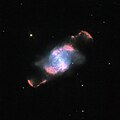Файл:IC 4634.jpg

Алдан карауның зурлыгы: 600 × 600 нокта. Башка ачыклык: 240 × 240 нокта | 637 × 637 нокта.
Төп файл (637 × 637 нокта, файл зурлыгы: 102 Кб, MIME төре: image/jpeg)
Файл тарихы
Файлның нинди булганлыгын күрү өчен «дата/вакыт» дигәненә басыгыз.
| Дата/вакыт | Кече рәсем | Үлчәмнәре | Кулланучы | Искәрмә | |
|---|---|---|---|---|---|
| агымдагы | 31 дек 2019, 09:09 |  | 637 × 637 (102 Кб) | BevinKacon | actual size from source |
| 23 июн 2010, 09:15 |  | 1280 × 1280 (151 Кб) | EricHS211 | {{Information |Description={{en|1=This striking Hubble image of the planetary nebula IC 4634 reveals two shining, S-shaped ejections from a dying star. This star, awash in glowing material at the centre of the picture, bloated as it aged and launched its |
Файлны куллану
Әлеге файл киләсе битне куллана:
Файлның гомуми кулланышы
Әлеге файл аста бирелгән викиларда куллана:
- ar.wikipedia.org проектында куллану
- be.wikipedia.org проектында куллану
- de.wikipedia.org проектында куллану
- en.wikipedia.org проектында куллану
- fr.wikipedia.org проектында куллану
- kk.wikipedia.org проектында куллану
- pl.wikipedia.org проектында куллану
- sr.wikipedia.org проектында куллану
- tr.wikipedia.org проектында куллану
- uk.wikipedia.org проектында куллану
- uz.wikipedia.org проектында куллану
- www.wikidata.org проектында куллану
